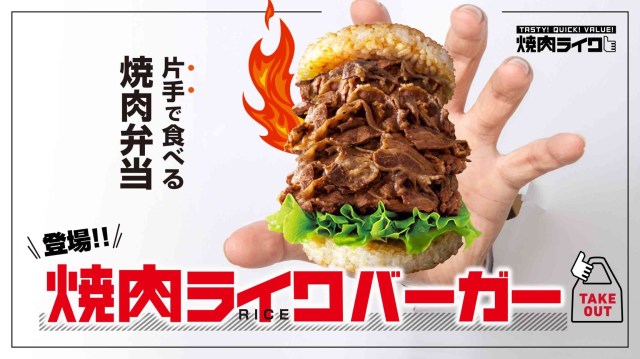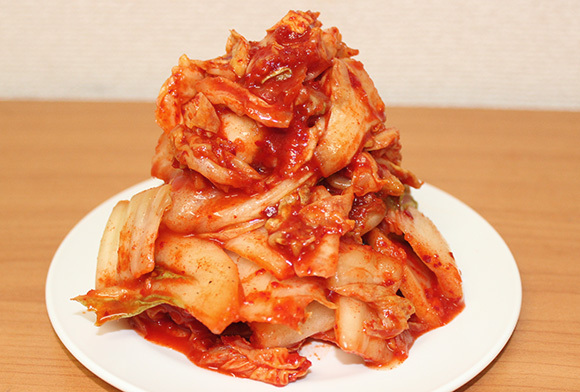kimchi
For those times when you’ve got someplace to be, and you’ve also got a craving for kimchi.
After viewing 60+ varieties of kimchi in a single shop alone, our reporter learns that she has much to learn about Korean cuisine.
New Japanese burger comes in three sizes, depending on how much of a meat tower you can handle.
One dish created in the video has some people angry that it was included when it’s not Chinese food.
Hot and spicy enough to distract you from the off-putting blackness of the bun and cure bland food Malay-se?
In the boring and often mildly terrifying world of being a competent adult, there comes a time when you have to start eating healthily or face the horrible consequences. Junk food somehow seems less appealing when you have to factor in the inevitable side effects such as bloating, stomach cramps, and bad skin.
So we’re always looking for new things to eat that have added beauty benefits, and recently a secret super recipe has come to our attention which involves adding a dollop of yogurt and kimchi to our rice bowls.
Slimy, sticky, and stinky – natto is a triumvirate of all the things picky eaters are likely to find unpalatable. While these fermented beans are actually incredibly good for your health (being rich in vitamins and fibre), they’re nonetheless something that even most Japanese people don’t like eating. But now there’s a new miracle product which claims to make natto perfectly tasty and edible, even for die-hard natto haters.
Have you ever been slapped in the face? If you have a sibling it’s likely to have occurred, or if you’ve wronged someone in just the right way, you’ve likely seen the fingers a flyin’. That hand is all up in your face, and whether you know it’s coming or it’s totally unexpected, it’s surprisingly pretty painful. You can imagine our astonishment when a segment of the Korean drama Everybody, Kimchi! took slapping to a whole new orangey, messy level!
You’ve probably heard of a Bloody Mary, a popular cocktail with a base of vodka and tomato juice, plus a host of other weird and wonderful flavourings such as Worcestershire or Tabasco sauce, horseradish, celery, pepper, salt, lemon juice, and so on. It may not sound appetizing but it has plenty of devotees, although that may be more to do with its reputation as a ‘hair of the dog’ hangover cure rather than its taste. But if you’re feeling adventurous, why not try the even more exotic flavours of a spicy Korean kimchi version?
America throws the best linguistic hissy fits when political relationships sour. Remember when Congress tried to change French fries to “freedom fries” because France didn’t want to come along on the Iraq invasion? Or how about when sauerkraut became so unpopular during World War I that makers suggested changing the name to the less Germanic “liberty cabbage”? Good times.
Well, it may be that the Yanks aren’t the only ones who want suitably patriotic cabbage. In Korea, it looks like Chinese cabbage, the vegetable used to make the most common variety of kimchi, is now being referred to as “kimchi cabbage” or just “cabbage”.
While traveling in Iwate Prefecture recently, one of our reporters stumbled across a brightly decorated pack of instant ramen. Although first drawn by the buxom moe character on the front, it was the name – Rare Cheese Kimchi Natto Ramen – that made this a must-buy.
If you were asked to think of a traditional Korean food, kimchi would most likely come to mind. If you’re unfamiliar with the dish, it’s a fermented, rather spicy, side dish made up of vegetables and various seasonings, and it forms the staple ingredient for hundreds of different Korean dishes. With kimchi valued so highly, it is perhaps no surprise that the Korean government wants to see it classified as intangible cultural heritage.
Kimchi is a fermented cabbage dish from Korea that is often referred to as “Korea’s national dish.” It’s so pungent that those who enjoy eating copious amounts of kimchi have been known to purchase a separate fridge dedicated to storing it. For decades, Korean mothers have sworn by the health benefits of adding kimchi to one’s diet, but now it seems scientists agree as well. New research published in the Journal of Medicinal Food suggests that eating even a small amount of kimchi every day may help lower cholesterol, LDL (“bad cholesterol”), and fasting blood glucose levels.
The world is full of countless foods and ways of eating them. It’s impossible to keep track of them all. I was surprised to discover salty watermelons, just as other people were surprised by my preference of putting peanut butter on waffles.
Such an incident happened on 19 January when a Japanese test maker unknowingly confused thousands of university entrance exam students with a recipe for a meat sauce calling for a “delicious kimchi base.”
Stereotypes; you have to love them.
Americans all own guns; every Brit has bad teeth; Asians make bad drivers; Koreans all eat Kimchi.
Usually stereotypes are utter nonsense- none of my American friends have ever held a real gun, let alone own one; a Japanese friend of mine once piloted my car along possibly the narrowest mountain road known to man when I was too freaked out to do it myself; and, as far as I can tell, my teeth are not in need of any urgent dental work.
But with 18kg (40lbs) of kimchi consumed per person in Korea each year, there might just be a grain of truth to that last stereotype.
So when news broke earlier today that Korea now imports more of its own national dish than it makes, it’s understandable that there were a few raised eyebrows… Read More
Summer seems to get hotter every year. For those of us who like spicy food it can be too burdensome to eat after working up enough of a sweat from the cooking alone.
To help this dilemma, a popular Korean Barbeque restaurant, Gyukaku, has announced that it will start selling a new style of frozen kimchi from 20 June.

















 Hayao Miyazaki says Happy New Year to Studio Ghibli fans with new art for Year of the Horse
Hayao Miyazaki says Happy New Year to Studio Ghibli fans with new art for Year of the Horse Starbucks Japan ready to get Year of the Horse started with adorable drinkware and plushies【Pics】
Starbucks Japan ready to get Year of the Horse started with adorable drinkware and plushies【Pics】 Live-action Attack on Titan musical reveals in-costume photos of full cast【Photos】
Live-action Attack on Titan musical reveals in-costume photos of full cast【Photos】 We revisited Sweets Paradise after a decade to see if Japan’s dessert buffet still delivers
We revisited Sweets Paradise after a decade to see if Japan’s dessert buffet still delivers Studio Ghibli releases 250 more free-to-download/use images from five films, and Totoro is here!
Studio Ghibli releases 250 more free-to-download/use images from five films, and Totoro is here! How to speak Japanese like a gyaru【2024 edition】
How to speak Japanese like a gyaru【2024 edition】 Dragon Tree On Coast Of Disaster-Struck Miyagi Prefecture Symbol Of Recovery, Draws Visitors From Across Japan
Dragon Tree On Coast Of Disaster-Struck Miyagi Prefecture Symbol Of Recovery, Draws Visitors From Across Japan 1 Year After Tōhoku Earthquake FujiFilm Reports Over 1,000,000 Photos Rescued and Cleaned
1 Year After Tōhoku Earthquake FujiFilm Reports Over 1,000,000 Photos Rescued and Cleaned We found possibly the quietest Japanese-style hotel in Tokyo’s bustling Shinjuku district
We found possibly the quietest Japanese-style hotel in Tokyo’s bustling Shinjuku district Top Secret Cookie Recipe Finally Comes to Light
Top Secret Cookie Recipe Finally Comes to Light 7-Eleven Japan’s ramen-cooking robot whipped us up a bowl of noodles【Taste test】
7-Eleven Japan’s ramen-cooking robot whipped us up a bowl of noodles【Taste test】 Cyberpunk anime meets traditional culture in Ghost in the Shell gold leaf Japanese changing screens
Cyberpunk anime meets traditional culture in Ghost in the Shell gold leaf Japanese changing screens 7 great places to see Mt. Fuji from without having to climb it
7 great places to see Mt. Fuji from without having to climb it Hello Kitty Choco Egg figures are an adorable trip through three periods of Japanese pop culture【Pics】
Hello Kitty Choco Egg figures are an adorable trip through three periods of Japanese pop culture【Pics】 Japan’s otoshidama tradition of giving kids money at New Year’s gets a social welfare upgrade
Japan’s otoshidama tradition of giving kids money at New Year’s gets a social welfare upgrade Lacquerware supplier to emperor of Japan and Pokémon team up for new tableware
Lacquerware supplier to emperor of Japan and Pokémon team up for new tableware Sumo Sanrio! Hello Kitty and pals team up with Japan Sumo Association for new merch【Pics】
Sumo Sanrio! Hello Kitty and pals team up with Japan Sumo Association for new merch【Pics】 Can a dirty butthole make you filthy rich in Japan? We’re starting a New Year’s lottery experiment
Can a dirty butthole make you filthy rich in Japan? We’re starting a New Year’s lottery experiment 7-Eleven Japan starts new temporary luggage storage service in over 300 branches
7-Eleven Japan starts new temporary luggage storage service in over 300 branches Disillusionment at Tsukiji’s tourist-target prices led us to a great ramen restaurant in Tokyo
Disillusionment at Tsukiji’s tourist-target prices led us to a great ramen restaurant in Tokyo Starbucks teams up with 166-year-old Kyoto doll maker for Year of the Horse decorations【Photos】
Starbucks teams up with 166-year-old Kyoto doll maker for Year of the Horse decorations【Photos】 Tokyo considering law requiring more trash cans following litter increase in heavily touristed area
Tokyo considering law requiring more trash cans following litter increase in heavily touristed area Tokyo’s Tsukiji sushi neighborhood asks tour groups to stay away for the rest of the month
Tokyo’s Tsukiji sushi neighborhood asks tour groups to stay away for the rest of the month Nintendo’s Kirby now delivering orders at Kura Sushi restaurants, but not in Japan
Nintendo’s Kirby now delivering orders at Kura Sushi restaurants, but not in Japan Tokyo event lets you travel back in time, for free, to celebrate 100 years since Showa era start
Tokyo event lets you travel back in time, for free, to celebrate 100 years since Showa era start Sanrio theme park in Japan announces plans to expand into a Sanrio resort
Sanrio theme park in Japan announces plans to expand into a Sanrio resort Japan may add Japanese language proficiency, lifestyle classes to permanent foreign resident requirements
Japan may add Japanese language proficiency, lifestyle classes to permanent foreign resident requirements Survey asks foreign tourists what bothered them in Japan, more than half gave same answer
Survey asks foreign tourists what bothered them in Japan, more than half gave same answer Japan’s human washing machines will go on sale to general public, demos to be held in Tokyo
Japan’s human washing machines will go on sale to general public, demos to be held in Tokyo Japan’s deadliest food claims more victims, but why do people keep eating it for New Year’s?
Japan’s deadliest food claims more victims, but why do people keep eating it for New Year’s? We deeply regret going into this tunnel on our walk in the mountains of Japan
We deeply regret going into this tunnel on our walk in the mountains of Japan Studio Ghibli releases Kodama forest spirits from Princess Mononoke to light up your home
Studio Ghibli releases Kodama forest spirits from Princess Mononoke to light up your home Major Japanese hotel chain says reservations via overseas booking sites may not be valid
Major Japanese hotel chain says reservations via overseas booking sites may not be valid Put sesame oil in your coffee? Japanese maker says it’s the best way to start your day【Taste test】
Put sesame oil in your coffee? Japanese maker says it’s the best way to start your day【Taste test】 No more using real katana for tourism activities, Japan’s National Police Agency says
No more using real katana for tourism activities, Japan’s National Police Agency says Starbucks Japan reveals new sakura drinkware collection, inspired by evening cherry blossoms
Starbucks Japan reveals new sakura drinkware collection, inspired by evening cherry blossoms Updated cherry blossom forecast shows extra-long sakura season for Japan this year
Updated cherry blossom forecast shows extra-long sakura season for Japan this year How to speak Japanese like a gyaru【2024 edition】
How to speak Japanese like a gyaru【2024 edition】 Dragon Tree On Coast Of Disaster-Struck Miyagi Prefecture Symbol Of Recovery, Draws Visitors From Across Japan
Dragon Tree On Coast Of Disaster-Struck Miyagi Prefecture Symbol Of Recovery, Draws Visitors From Across Japan 1 Year After Tōhoku Earthquake FujiFilm Reports Over 1,000,000 Photos Rescued and Cleaned
1 Year After Tōhoku Earthquake FujiFilm Reports Over 1,000,000 Photos Rescued and Cleaned We found possibly the quietest Japanese-style hotel in Tokyo’s bustling Shinjuku district
We found possibly the quietest Japanese-style hotel in Tokyo’s bustling Shinjuku district Top Secret Cookie Recipe Finally Comes to Light
Top Secret Cookie Recipe Finally Comes to Light Hello Kitty Choco Egg figures are an adorable trip through three periods of Japanese pop culture【Pics】
Hello Kitty Choco Egg figures are an adorable trip through three periods of Japanese pop culture【Pics】 Shonen Jump’s anime heroes punch huge craters in Shinjuku Station, create photo spots
Shonen Jump’s anime heroes punch huge craters in Shinjuku Station, create photo spots Minimal effort, loads of flavor: Make juicy roast beef in your rice cooker with vacuum cooking!
Minimal effort, loads of flavor: Make juicy roast beef in your rice cooker with vacuum cooking! Stinkiest sushi in the world is now an ice cream flavour in Japan
Stinkiest sushi in the world is now an ice cream flavour in Japan Lovers’ Final Emails Moments Before Tsunami: “Don’t get yourself killed!”
Lovers’ Final Emails Moments Before Tsunami: “Don’t get yourself killed!” Revisit 20 Photos of Some of The Most Powerful Moments and People in Modern History
Revisit 20 Photos of Some of The Most Powerful Moments and People in Modern History The best Starbucks Japan Frappuccinos we want to drink again in 2026
The best Starbucks Japan Frappuccinos we want to drink again in 2026 Pizza Hut Japan’s hot lucky bags are perfect for a New Year’s pizza party
Pizza Hut Japan’s hot lucky bags are perfect for a New Year’s pizza party W.T.F. Japan: Top 5 kanji with ironic meanings【Weird Top Five】
W.T.F. Japan: Top 5 kanji with ironic meanings【Weird Top Five】